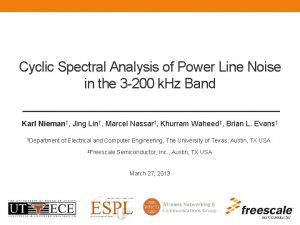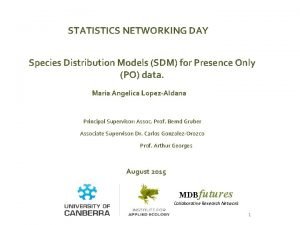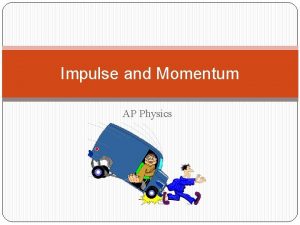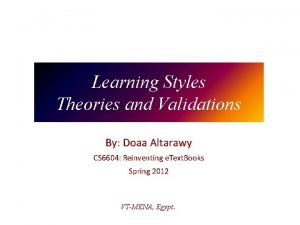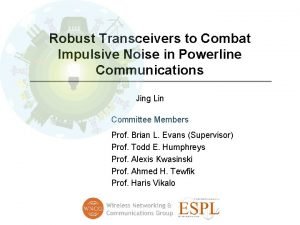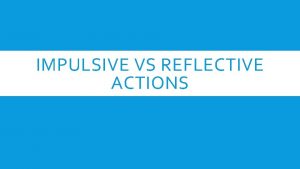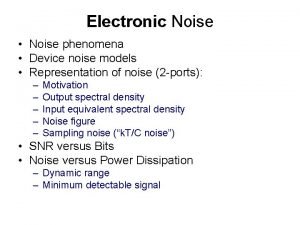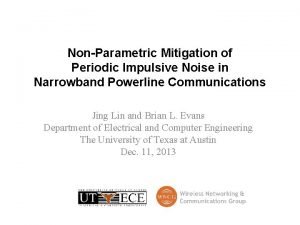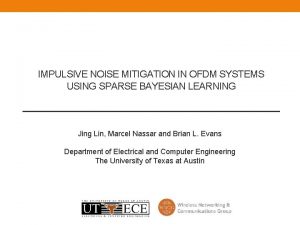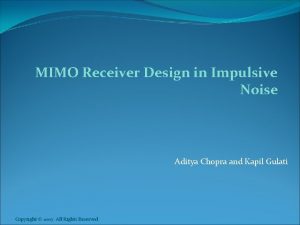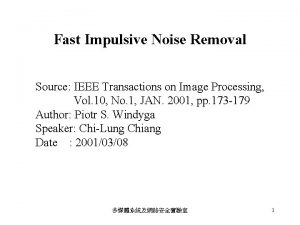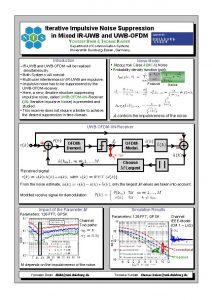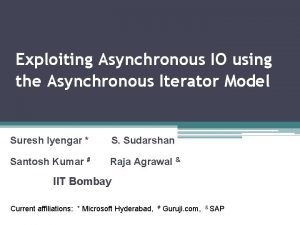STATISTICAL MODELING OF ASYNCHRONOUS IMPULSIVE NOISE IN POWERLINE



![3 Prior Work on Asynchronous Noise • Empirical Measurements [Zimmermann, Dostert 2002] • Empirical 3 Prior Work on Asynchronous Noise • Empirical Measurements [Zimmermann, Dostert 2002] • Empirical](https://slidetodoc.com/presentation_image_h/211e61d7dfa4df82e31b7ea708960110/image-4.jpg)









![13 References [1] M. Zimmermann and K. Dostert, “Analysis and modeling of impulsive noise 13 References [1] M. Zimmermann and K. Dostert, “Analysis and modeling of impulsive noise](https://slidetodoc.com/presentation_image_h/211e61d7dfa4df82e31b7ea708960110/image-14.jpg)
- Slides: 14

STATISTICAL MODELING OF ASYNCHRONOUS IMPULSIVE NOISE IN POWERLINE COMMUNICATION NETWORKS Marcel Nassar, Kapil Gulati, Yousof Mortazavi, and Brian L. Evans Department of Electrical and Computer Engineering The University of Texas at Austin

1 Outline • Intro on Noise in Powerline Communications (PLC) • Prior Work on Asynchronous Noise Modeling • System Model and Assumptions • Summary of the Approach • Simulation Results and Verification

2 Noise in Powerline Communications Background Noise Periodic and Cyclostationary Noise Asynchronous Impulsive Noise time • • colored noise superposition of lowerintensity sources decreases with frequency includes narrowband interference • • • [Zimmermann 02] modulated periodic signal cylostationary in time and frequency synchronous and asynchronous wrt AC mains Sources: rectified and switched power supplies dominant in 3 -500 k. Hz [Zimmermann 02], [Corripio 06], [Reiken 11], [Nassar 12] • • • Caused by switching transients Duration: micro to millisecond arbitrary inter-arrival time 50 db above background noise present 0. 2 -20 MHz [Zimmermann 02], [Di. Bert 11]
![3 Prior Work on Asynchronous Noise Empirical Measurements Zimmermann Dostert 2002 Empirical 3 Prior Work on Asynchronous Noise • Empirical Measurements [Zimmermann, Dostert 2002] • Empirical](https://slidetodoc.com/presentation_image_h/211e61d7dfa4df82e31b7ea708960110/image-4.jpg)
3 Prior Work on Asynchronous Noise • Empirical Measurements [Zimmermann, Dostert 2002] • Empirical Fitting and Modeling • Hidden Markov Models [Zimmermann, Dostert 2002] • Middleton’s class-A [Umehara, Yamaguchi, Morihiro 2004] • Gaussian Mixture [Di Bert, Caldera, Schwingshackl, Tonello 2011] • Rayleigh [Chan, Donaldson 1989 ] • Nakagami-m [Meng, Guan, Chen 2005]

4 Statistical Models • Parameter Description Number of Gaussian components Mixing probabilities Component variances (power) Parameter Description Overlap index (indicates impulsiveness) Mean intensity

5 Powerline Communication Networks Sources of Asynchronous Noise: Bursty Wireless Transmissions Uncoordinated users (coexistence issues) Switching Transients Objective: Statistical-Physical model for interference at the receiver from M sources Interference from source i

6 Interference from a Single Source i ( ) reference time t=0 Noise Envelope window of duration T with ki impulses

7 • Assumptions and System Model Channel experienced pathloss Isof impulse l active Amplitude byimpulsel at l t=0 at t=0?

8 Summary of Statistical Modeling • Total Interference : • After messy calculations, the characteristic function is: Middleton’s Class-A • Aggregate for multiple Interfering sources

9 Modeling Results Dominant Interference Source Homogeneous PLC Network General PLC Network

10 Simulation Results (Tail Probabilities) General PLC Network Homogenous PLC Network Larger Networks with more interferers have higher interference power with smaller tails.

11 Some Measurements of PLC Noise Collected in the 3500 k. Hz range indoors Gaussian Mixture provide a good fit as well

12 Thank you Questions?
![13 References 1 M Zimmermann and K Dostert Analysis and modeling of impulsive noise 13 References [1] M. Zimmermann and K. Dostert, “Analysis and modeling of impulsive noise](https://slidetodoc.com/presentation_image_h/211e61d7dfa4df82e31b7ea708960110/image-14.jpg)
13 References [1] M. Zimmermann and K. Dostert, “Analysis and modeling of impulsive noise in broad-band powerline communications, ” IEEE Trans. Electromagn. Compat. , vol. 44, no. 1, pp. 249– 258, 2002. [2] D. Umehara, H. Yamaguchi, and Y. Morihiro, “Turbo decoding in impulsive noise environment, ” in Proc. IEEE Global Telecommun. Conf. , vol. 1, 2004, pp. 194– 198. [3] L. Di Bert, P. Caldera, D. Schwingshackl, and A. Tonello, “On noise modeling for power line communications, ” in Proc. Int. Symp. Power-Line Comm. and its Appl. , 2011, pp. 283– 288. [4] H. Meng, Y. Guan, and S. Chen, “Modeling and analysis of noise effects on broadband power-line communications, ” IEEE Trans. Power Del. , vol. 20, no. 2, pp. 630– 637, 2005. [5] M. Chan and R. Donaldson, “Amplitude, width, and interarrival distributions for noise impulses on intrabuilding power line communication networks, ” IEEE Trans. Electromagn. Compat. , vol. 31, no. 3, pp. 320 – 323, 1989. [2] D. Middleton, “Statistical-physical models of electromagnetic interference, ” IEEE Trans. Electromagn. Compat. , vol. 19, no. 3, pp. 106– 127, 1977. [3] K. Gulati, B. L. Evans, J. G. Andrews and K. R. Tinsley, "Statistics of Co-Channel Interference in a Field of Poisson and Poisson-Poisson Clustered Interferers", IEEE Transactions on Signal Processing, vol. 58, no. 12, Dec. 2010, pp. 6207 -6222.
 Powerline noise
Powerline noise Chopper herbicide
Chopper herbicide Pcm companding
Pcm companding Sdm species distribution model
Sdm species distribution model Role modeling theory
Role modeling theory Relational modeling vs dimensional modeling
Relational modeling vs dimensional modeling Intermittent explosive disorder
Intermittent explosive disorder Moral development in physical education
Moral development in physical education Impulsive force
Impulsive force Fronte d'onda
Fronte d'onda Static character in romeo and juliet
Static character in romeo and juliet Impulsive force example
Impulsive force example How is romeo impulsive
How is romeo impulsive Impulsive, emotional romeo acts as a character foil for
Impulsive, emotional romeo acts as a character foil for Impulsive learners
Impulsive learners
